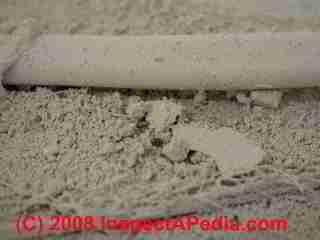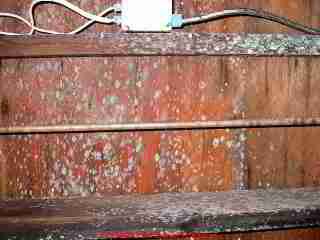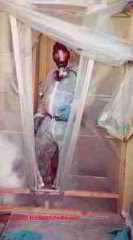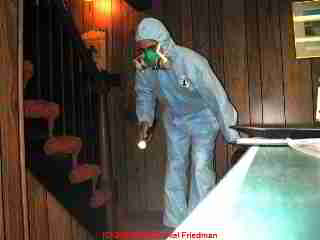 How to Choose a Mold Remediator
How to Choose a Mold Remediator
Advice on how to hire someone who puts your needs first
- POST a QUESTION or COMMENT about how to select an expert mold or water damage cleanup / repair company
How to find & choose a good mold remediation contractor.
Page top photo: InspectApedia's editor during a post-mold-remediation inspection in the basement of a northern U.S. home.
This article series describes how to assure that the scope of work specified in a mold or other indoor environmental cleanup has not been tainted by the conflict of interest of a business or financial relationship between the initial consultant and the company who will perform the actual cleanup and building repairs.
InspectAPedia tolerates no conflicts of interest. We have no relationship with advertisers, products, or services discussed at this website.
- Daniel Friedman, Publisher/Editor/Author - See WHO ARE WE?
Hiring a Mold Remediation or Flood Damage Restoration Contractor
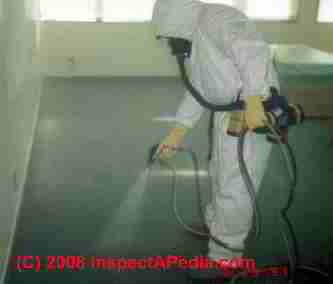 How to find and hire an effective and thorough mold remediation contractor.
How to find and hire an effective and thorough mold remediation contractor.
First: do you need a professional cleanup company at all?
Small areas of mold contamination, less than about 30 square feet of contiguous mold, can normally be removed and cleaned-up by a homeowner or handyman or other cleaning contractor.
That procedure is given
at MOLD CLEANUP, DO IT YOURSELF.
Naturally if, during the conduct of a small mold clean-up project you discover a larger area of mold contamination, then work should stop and you should consult a professional.
MOLD / ENVIRONMENTAL EXPERT, HIRE ? - when to hire an expert - offers guidelines for deciding when you need a professional .
Photo above of the fellow in white tyvek spraying the carpeted floor: in this mold-contaminated apartment the contractor relied entirely on use of a sanitizer spray, even spraying a previously-wet moldy wall-to-wall carpet.
Most experts agree that moldy drywall and moldy or even previously soaked carpet and padding should simply be removed.
[Click to enlarge any image]
Such "suiting up" in protective gear is not required in buildings where there is not a suspected or obvious mold hazard, and we warn that over-dressing can inappropriately scare building occupants. In any case, regardless of how we dress, in our opinion and that of many other professional and industry experts:
It is unethical and a conflict of interest for the investigator who is going to specify what mold remediation cleanup work is needed in a building to also offer to perform the cleanup work itself.
Question: how do I find a good remediation company?
Curious how to hire a good remediation company. Most just want to spray the mold not properly remediate it. I’m in Seattle Washington and need help fast. - Anonymous by private email 2022/06/04
Moderator reply: what to ask, where & how to find a reliable mold remediator
Thank you for a helpful question.
Unfortunately it's difficult one to answer with complete assurance. That's why you will read in our opinions given below that a lot depends on a very qualified and very independent inspection by an expert before and after the job.
As with many other fields there's a great range of quality of work mold remediation jobs and among mold remediation contractors.
Throughout this article and at the page bottom RECOMMENDED ARTICLES we suggest additional reading. The more you can stand to read about proper mold or water damage remediation the better prepared you will be both to choose a contracto who will do the work that you need and to be able to ask questions and interpret the answers you're given about the mold cleanup process.
Even good mold remediators may have a bad day
Having inspected a great many moldy buildings and mold remediation jobs, I have found that even a particular mold remediation company who had done good work in the past might not always do so in the future.
The success of any water damage restoration job or mold remediation contract seems to depend not just on the particular crew but in particular on the supervision of the work.
Photo above: this mold "remediation" contractor left all of the moldy debris in the building's basement and crawl space, but sprayed plenty of fungicidal sealant.
Mold remediator referrals & certifications
You may want to start by trying to find referrals for people that you know who had good work done. In most areas mold remediators are licensed by the state or province.
Provided that your state or province licenses mold or water damage restoration contractors, you should hire only a licensed contractor to do the work.
 Mold remediator certifications held by your contractor might be helpful, or not. While holding a membership in a professional association that requires education, training, perhaps passing an exam can provide a credible credential, other certifications are principally a marketing tool.
Mold remediator certifications held by your contractor might be helpful, or not. While holding a membership in a professional association that requires education, training, perhaps passing an exam can provide a credible credential, other certifications are principally a marketing tool.
Our dog Katie, shown here waiting to begin assisting during a mold inspection at a New York home (in 1972) actually held a certification and license as an environmental inspector. We had to fill in the form and send her application fee because her paw-writing was illegible. But she got her certificate a week later.
Katie assisted in visual inspections and though she had an acute sense of smell, we did not rely on her ability to sniff-out mold contamination.
Read why some mold "testing" services are questionable if not downright bogus at MOLD-SNIFFING DOGS.
It's also the case that mold remediation companies who are referred by your insurance company will also have a conflict of interest as they probably will regard themselves as working for the insurance company not for you. In those cases there's a great pressure on the remediation company to do the job as cheaply as possible.
My experience and opinion argue that it is in the long run most expensive to do the job thoroughly and correctly in the first place then it is to have to come back to the building and do the job over and over again until it's gotten right.
The primary standard of care for the professional mold remediation industry is the (IICRC) Institute of Inspection, Cleaning and Restoration Certification’s S520 Standard and Reference Guide for Professional Mold Remediation. We provide links to this standard and to the IICRC at the end of this page.
What to ask a prospective mold remediator
Ask the mold remediation company representative to describe their procedure in general.
I say "in general" because the person you are speaking with is probably going to say, quite reasonably, that they don't know exactly what's going to be needed until we see the job.
I agree with you the people who come in and simply spray surfaces are not doing an acceptable job.
For example if there is moldy drywall that you can see it's usually the case that the cavity side of the drywall is contaminated and it's possible that insulation in a wall or ceiling cavity is contaminated as well. If that's the case then those materials have to be removed and the exposed surfaces cleaned.
Then it's perfectly reasonable if after-cleaning the contractor want to spray a fungicidal sealant, as an additional insurance against future mold growth and it can isolate and secure the few remaining airborne spores that settle on those surfaces.
But it's very tempting for companies to move fast and work cheap by doing only superficial work so I'm glad that you're already alert for that problem.
Photo above: this moldy floor, seen from below, was also wet. Simply cleaning the mold without fixing the source of moisture is not going to be a durable mold clean-up job.
Ask the mold remediator who is actually going to do the work.
Without an expert and experienced superivisor on site throughout the mold remediation job, even well-intentioned workers can make serious mistakes that leave mold contamination, cross-contaminate the building, or even cause someone to become sick or injured.
Ask the mold remediator's credentials, licenses, experience.
are the company and its supervisor licensed and certified meeting the requirements of your state or province?
Is the mold remediation contractor insured? Who pays if the contractor makes a costly mistake or injures a worker?
What to listen for when your mold remediator talks
The basic steps that you're listening for are that the there will be
- Find the mold: a thorough inspection to identify where the mold contamination is located.
There may be mold contamination in in more than one building area. - Set up containment: assurance that if it's not the entire building being treated, proper containment will be set up.
- Protect both occupants and workers: by proper containment and by proper use of personal protective equipment for workers (PPE).
In some circumstances the building occupants may need to live elsewhere, out of the building, during remediation. - Remove the mold: steps to find and remove moldy materials that cannot be cleaned (carpets, padding, couches, drywall)
- Clean the surfaces: steps to clean surfaces that can be cleaned.
- Fix the cause of mold: steps to find and fix the cause of the mold growth in the first place - usually building leaks.
See details at HOW TO PREVENT FUTURE MOLD
In the case of moldy drywall on a ceiling or wall the usual procedure is to bid the job based on an initial estimate of the moldy area but to make clear that material will be removed until inspection shows a clear margin of mold free surfaces.
In a wall that margin might be one stud bay or in a ceiling one joist or rafter bay that has been opened and found to be mold free.
Think twice about hiring any of these remediation contractors
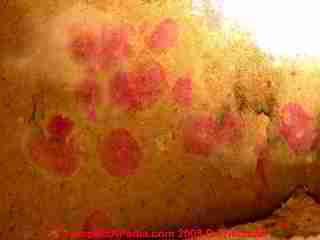 Photo: this extensive mold contamination was found on the wall-cavity side of drywall throughout a home after a flood damage restoration company reported to the insurance company that the restoration work was successful and complete.
Photo: this extensive mold contamination was found on the wall-cavity side of drywall throughout a home after a flood damage restoration company reported to the insurance company that the restoration work was successful and complete.
The company used a "water extraction" method that ran dehumidifiers and fans in the water-damaged building, leaving the wall cavities wet, un-explored, and so extensively-mold-contaminated that when occupants returned to the home they became ill.
- Any company that tells you that is going to leave water damaged or moldy carpeting, carpet padding, drywall, insulation, or heavy upholstered couches that were wet and moldy if someone that you don't want to hire.
- Any company that relies on ozone treatments and topical spray is, sanitizers, alone, Etc without any further or deeper cleaning and removal of un-cleanable materials is a company that you don't want to hire.
See MOLD SANITIZER, SPRAY, BIOCIDE USE GUIDE - when where how and why to use biocide or fungicidal sprays and encapsulating mold sprays and paints.
- Any company who insists that you can only use their clearance inspector is a company you don't want to hire.
- Any company who responds to your questions with arm waving, offering nothing specific about the work, or who gives an answer something like
- "Don't worry about it honey we'll take care of everything"
is also a company you don't want to hire.
- Any company whose workers show up and appear to be workers using no training and no personal protective equipment such as protective respirators and eye protection is a company that you will be sorry to have hired.
More details are
at MOLD CLEANUP - MISTAKES to AVOID
Use an independent pre- and post-remediation clearance inspector
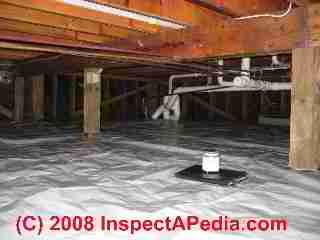 You and the mold company should agree at the outset that when the work is completed and a mold clearance inspection is to be done, there will be an expert inspection and testing done by a person who has absolutely no relationship with a remediation company.
You and the mold company should agree at the outset that when the work is completed and a mold clearance inspection is to be done, there will be an expert inspection and testing done by a person who has absolutely no relationship with a remediation company.
There is an innate conflict of interest if the mold remediation company is also doing the work to define the scope that's needed at the house shut and doing the work to to find that their work was done correctly in other words performing their own clearance inspection.
Photo: this crawl space was immaculate; previously moldy surfaces cleaned, moldy debris removed, fungicidal sealant applied to wood surfaces to improve its resistance to both moisture and future mold growth, water entry problems fixed, and a thorough moisture barrier placed over the dirt floor of the crawl area.
Our inspection included air tests for mold using the Burkard personal air sampler shown in the photograph.
It's also my opinion that an independent clearance inspection protects the mold company as well as you. But that person needs to be truly independent not someone who's a friend or Business Connection or who constantly works with remediation company.
In my opinion although it's not a hard fast rule, it's best that the independent expert performer preliminary inspection to define an initial scope of work. I know that the mold remediation company likes to do that themselves and that's perfectly understandable.
However when an independent expert has seen the building before the mold remediation job and that same person is going to come back after the job, they will be better equipped to have an idea of the scope of work was adequate.
Your mold remediation clearance inspector should inspect and test not only the area where work was performed but also areas that were outside of the containment area to be sure that there was not cross-contamination that requires additional cleaning.
There are also test conditions that should be respected for a valid post mold remediation clearance inspection. You can read about those in detail at
Don't hire a mold clearance inspector who doesn't inspect. Simply "testing" a building for mold, without a thorough inspection and data gathering is unreliable.
See details
at MOLD CLEANUP AREA CROSS CONTAMINATION
and at MOLD TESTING METHOD VALIDITY
Mold Remediator Selection Research
- HUD, REBUILD HEALTHY HOMES, GUIDE TO POST-DISASTER RESTORATION FOR A SAFE AND HEALTHY HOME [PDF] U.S. Department of Housing and Urban Development (HUD)
Check Credentials & Hire only licensed & insured contractors, see pp. 33-35
Cross-contamination protection, see pp.25-28 & pp. 39-40
Mold Removal Guidelines, see pp. 41 & 50-53
Remove previously or currently-wet or moldy insulation, foam padding, carpets, see pp. 48-49 - ANSI Standard & Institute of Inspection Certification (2008). S520 Standard and Reference Guide for Professional Mold
Remediation. Website: https://webstore.ansi.org/ Provided to ANSI by the Institute of Inspection, Cleaning and Restoration Certification [IICRC], cited below. Web: https://iicrc.org/
Description:
This document is written for use by those involved in the mold remediation industry, primarily for mold remediation companies and workers, and secondarily, for others who investigate or assess mold complaints, prepare remediation specifications, protocols or procedures, and manage remediation projects, (e.g., indoor environmental professionals (IEPs), other specialized experts) and finally, for other potential materially interested parties (e.g., consumers and occupants, property owners and managers, insurance company representatives, government and regulatory bodies).
The S520 is a procedural standard. It is based on reliable remediation principles, review of available scientific and industry literature and information and practical experience. In addition, there has been extensive consultation with, and information obtained from, numerous other sources.
The Second Edition of the S520 has been updated and rewritten. An additional Chapter and Section have been added covering Building and Material Science, and an additional section has been added covering Equipment, Tools and Materials.
This document supersedes the IICRC S520 Standard and Reference Guide for Professional Mold Remediation (S520 First Edition 2003, 2004). - IICRC, REFERENCE GUIDE FOR PROFESSIONAL
MOLD REMEDIATION [PDF] 3rd Ed., (2015) Preview. The full version can be purchased from the ANSI store given above.
Third EditionInstitute of Inspection, Cleaning and Restoration Certification [IICRC], 4043 South Eastern Avenue, Las Vegas, NV 89119 . USA Customer Service: 844-464-4272 Standards: 844-216-7036 Press & Media: Email press@iicrcnet.org Web: https://iicrc.org/
Excerpt from Disclaimer:
The Institute of Inspection, Cleaning and Restoration Certification R520 Reference Guide for Professional Mold Remediation (referred to as the “Reference Guide”) is intended to provide information about the remediation of mold-contaminated structures, systems, and contents and to assist individuals and entities working in the mold remediation industry in establishing and maintaining their professional competence.
Note: IICRC has offices also in Europe, Asia, and Japan.
The IICRC is the Institute of Inspection Cleaning and Restoration Certification, a non-profit organization for the Inspection, Cleaning, and Restoration Industries. The IICRC, originally named the International Institute of Carpet and Upholstery Cleaning Inc. (IICUC), was founded in 1972 by Ed York. Since starting in 1972, the IICRC has evolved into a global organization with more than 49,000 active Certified Technicians and more than 6,500 Certified Firms around the world. - Kleinheinz, G. T., B. M. Langolf, and E. Englebert. "Characterization of airborne fungal levels after mold remediation." Microbiological research 161, no. 4 (2006): 367-376.
- Laquatra, Joseph, and Claudette Reichel. HIRING a MOLD REMEDIATION CONTRACTOR [PDF] (2015) Louisiana State University Agricultural Center, 2015. Retrieved 2022/06/05 original source: https://www.lsuagcenter.com/NR/rdonlyres/9EC675F2-3E81-4A68-86AF-E86D10CEDED9/101756/pub3242hiringmoldcontractor115.pdf
Excerpts:
A mold remediation professional should follow procedures of a nationally recognized industry protocol and use specialized equipment. “Recommended Steps for Mold Cleanup in Flooded Homes” (next page) is included to provide you with an awareness of basic recommended remediation steps and restoration suggestions to help you achieve as safe and effective a remediation job as you can secure. - Light, Ed, J. Bailey, and R. Gay. NEW PROTOCOL FOR THE ASSESSMENT AND REMEDIATION OF INDOOR MOLD GROWTH [PDF] In Proceedings of 12th International Conference of Indoor Air Quality and Climate, vol. 1, pp. 163-168. 2011.
Summary:
The effectiveness of current response procedures for addressing mold growth is evaluated, and the authors recommend a new protocol for building assessment and remediation. Assessment based primarily on mold testing has significant limitations and may fail to identify sites with mold growth.
Microbiological testing is replaced by engineering evaluation with a focus on site moisture dynamics.
Critical performance objectives for remediation are to restore the site to conditions preceding water damage while preventing occupant exposure to airborne mold generated by the repair process. Hazardous material abatement procedures are generally not needed for mold remediation. - New York City Department of Health GUIDELINES ON ASSESSMENT AND REMEDIATION OF FUNGI IN THE INDOOR ENVIRONMENTS [PDF] (2008) New York City Department of Health and Mental Hygiene , New York, NY. - retrieved 2022/06/05, original source: https://www1.nyc.gov/assets/doh/downloads/pdf/epi/epi-mold-guidelines.pdf
Preface excerpt:
These guidelines are intended for use by building owners and managers, environmental contractors and environmental consultants. It is also available for general distribution to anyone concerned about indoor mold growth.
The attached fact sheet, “Mold Growth: Prevention and Cleanup for Building Owners and Managers,” is a simplified summary of these guidelines, which may be useful for building owners, managers and workers.
It is strongly recommended that the complete guidelines be referred to before addressing the assessment or remediation of indoor mold growth.
- Robinson, Christine. THE ASSOCIATIONS BETWEEN MOLD REMEDIATION PRACTICES AND POST-REMEDIATION VERIFICATION TESTING FOR RESIDENTIAL STRUCTURES IN SOUTHERN CALIFORNIA FROM 2008 TO 2019 [PDF] PhD diss., Trident University International, 2020. - This graduate work has been published as open access.
Excerpt:
The purpose of this study was to determine the correlations between how closely water damage mitigation and mold remediation work follows consensus guidelines and the results of Indoor Environmental Professional assessments, especially mold spores. - Silicato, Steven R. "Mold remediation: a practical approach." Plant Engineering 57, no. 6 (2003): 50-50.
- Stecker, Sharon, and Eric Harrison. "Finding and selecting a mold remediation contractor." Risk Management 50, no. 2 (2003): 26-28.
Excerpts:
Unlike lead or asbestos, mold is a dynamic contaminant. And mold investigation and abatement utilize interdisciplinary practices and multiple documentation methods. The techniques for getting mold out of heating, ventilation and air conditioning (HVAC) systems, for example, are very different from those that apply to a contaminated basement.
And if a remediation is not properly planned or implemented, mold probably will return, and very likely spread to other locations.
In the race to grab a share of the market, more than a few mold remediation contractors have rushed to offer their services. Even a contractor with the best intentions, however, may overlook important details and precautions.
So how do you find a remediator you can trust? Unfortunately, due to the current lack of standards governing the industry, buyers of remediation services face a bewildering array of self-described certifications, many of which may not be consistent or comprehensive enough to assure quality service.
The good news is several industry organizations are working to develop standardized education, uniform standards of care and acknowledged certifications. Until these are available, the following suggestions should help you find the right people to help rid your company of its mold problem. - Texas State Department of Health. 2007. TEXAS MOLD ASSESSMENT AND REMEDIATION RULES [PDF] (2007)Environmental Health Group, Mail Code #1987 Environmental Health Group, Mail Code #1987
Policy, Standards, and Quality Assurance Unit Policy, Standards, and Quality Assurance Unit
Division for Regulatory Services Division for Regulatory Services
Texas Department of State Health Services Texas Department of State Health Services
1100 West 49th Street Street
Austin, Texas 78756 Austin, Texas 78756
512-834-6773 or 1 6773 or 1 6773 or 1-800-293-0753 extension 3600 0753 extension 3600 0753 extension 3600
www.dshs.state.tx.us/mold www.dshs.state.tx.us/mold
Note:
For questions regarding mold licensing mold licensing mold licensing in Texas, please contact: the Texas Environmental and Sanitation Licensing Group, (512) 834-6610 or (800) 572-5548 Fax: (512) 834-6614
Excerpt:
This subchapter contains requirements for the licensing and registration of persons performing mold assessments and mold remediation, requirements for the accreditation of mold training providers, minimum work standards for the conduct of mold assessments and remediation by licensed and registered persons, a code of ethics, and penalties.
- US EPA - Mold Remediation in Schools and Commercial Building [PDF] - US Environmental Protection Agency
- US EPA - UNA BREVA GUIA a MOHO / HONGO - en Espanol
- US EPA - MOLD REMEDIATION in SCHOOLS & COMMERCIAL BUILDINGS - - US EPA
- Also see the citations at page endReferences or Citations
...
Continue reading at CONFLICTS OF INTEREST, or select a topic from the closely-related articles below, or see the complete ARTICLE INDEX.
Or see these
Recommended Articles
- CHOOSE a FLOOD DAMAGE RESTORATION or MOLD REMEDIATOR
- CONFLICTS OF INTEREST
- FLOOD REPAIR CONTRACTORS - how to work with the contractor
- HOW MUCH SHOULD YOU PAY - for professional inspection or testing services? It may cost more to pay too-little than to pay too-much.
- INADEQUATE MOLD REMEDIATION PLAN
- MOLD CLEANUP GUIDE- HOW TO GET RID OF MOLD - home
- MOLD & ENVIRONMENTAL CLEANUP COMPANIES
- MOLD / ENVIRONMENTAL EXPERT, HIRE ? - when to hire an expert
- OTHER PEOPLE's MONEY - Watch out for experts whose advice spends your money mostly to protect themselves rather than you
- MOLD INSPECTORS & MOLD TESTERS
- WHEN TO STOP LOOKING FOR MOLD
Suggested citation for this web page
CHOOSE a FLOOD DAMAGE RESTORATION or MOLD REMEDIATOR at InspectApedia.com - online encyclopedia of building & environmental inspection, testing, diagnosis, repair, & problem prevention advice.
Or see this
INDEX to RELATED ARTICLES: ARTICLE INDEX to MOLD CONTAMINATION & REMEDIATION
Or use the SEARCH BOX found below to Ask a Question or Search InspectApedia
Ask a Question or Search InspectApedia
Try the search box just below, or if you prefer, post a question or comment in the Comments box below and we will respond promptly.
Search the InspectApedia website
Note: appearance of your Comment below may be delayed: if your comment contains an image, photograph, web link, or text that looks to the software as if it might be a web link, your posting will appear after it has been approved by a moderator. Apologies for the delay.
Only one image can be added per comment but you can post as many comments, and therefore images, as you like.
You will not receive a notification when a response to your question has been posted.
Please bookmark this page to make it easy for you to check back for our response.
IF above you see "Comment Form is loading comments..." then COMMENT BOX - countable.ca / bawkbox.com IS NOT WORKING.
In any case you are welcome to send an email directly to us at InspectApedia.com at editor@inspectApedia.com
We'll reply to you directly. Please help us help you by noting, in your email, the URL of the InspectApedia page where you wanted to comment.
Citations & References
In addition to any citations in the article above, a full list is available on request.
- [6] "Indoor Air Quality Problem Solving Wheel", U.S. EPA (included in [3] above. EPA Telephone for IAQ information & publications: 800-438-4318 S/N 055-000-00390-4
- ENVIRONMENTAL HEALTH & INVESTIGATION BIBLIOGRAPHY - our technical library on indoor air quality inspection, testing, laboratory procedures, forensic microscopy, etc.
- In addition to citations & references found in this article, see the research citations given at the end of the related articles found at our suggested
CONTINUE READING or RECOMMENDED ARTICLES.
- Carson, Dunlop & Associates Ltd., 120 Carlton Street Suite 407, Toronto ON M5A 4K2. Tel: (416) 964-9415 1-800-268-7070 Email: info@carsondunlop.com. Alan Carson is a past president of ASHI, the American Society of Home Inspectors.
Thanks to Alan Carson and Bob Dunlop, for permission for InspectAPedia to use text excerpts from The HOME REFERENCE BOOK - the Encyclopedia of Homes and to use illustrations from The ILLUSTRATED HOME .
Carson Dunlop Associates provides extensive home inspection education and report writing material. In gratitude we provide links to tsome Carson Dunlop Associates products and services.


